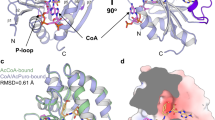Abstract
Adenylosuccinate synthetase (AdSS) functions at the branchpoint of purine nucleotide metabolism leading to the synthesis of AMP. The enzyme is inhibited by a metabolite of alanosine, an aspartic acid analog that is highly cytotoxic for most cells. We show here that it is possible to use alanosine selection to isolate from a population of transformants those cells having the highest levels of AdSS activity resulting from uptake and expression of AdSS minigenes. Transformants isolated in this way were selected for resistance to even higher concentrations of alanosine and resulted in the isolation of cells with highly amplified copies of the transfected AdSS minigenes. We demonstrated that nonselectable genes can be cotransferred and coamplified with AdSS minigenes. These findings indicate that AdSS minigenes can be used as dominant amplifiable genetic markers in mammalian cell.
Similar content being viewed by others

Literature Cited
Kaufman, R.J. (1990).Methods Enzymol 185:537–566.
Urlaub, G., and Chasin, L.A. (1980).Proc. Natl. Acad. Sci. U.S.A. 77:4216.
Kaufman, R.J., Murtha, P., Ingolia, D.E., Yeung, C.-Y., and Kellems, R.E. (1986).Proc. Natl. Acad. Sci. U.S.A. 83:3136–3140.
Wood, C.R., Dorner, A.J., Morris, G.E., Alderman, E.M., Wilson, D., O'Hara, R.M., and Kaufman, R.J. (1990).J. Immunol. 145:3011–3016.
Kaufman, R.J., Wasley, L.C., Davies, M.V., Wise, R.J., Israel, D.I., and Dorner, A.J. (1989).Mol. Cell Biol. 9:1233–1242.
Dorner, A.J., Krane, M.G., and Kaufman, R.J. (1988).Mol. Cell Biol. 8:4063–4070.
Israel, D.I., and Kaufman, R.J. (1989).Nucleic Acids Res. 17:4589–4604.
Kellems, R.E. (1993). Gene Amplification in Mammalian Cells: A Comprehensive Guide (Marcel Dekker, Inc., New York).
MacGregor, G.R., and Caskey, C.T. (1989).Nucleic Acids Res. 17:2365.
Chen, C., and Okayama, H. (1987).Mol. Cell. Biol. 7:2745–2752.
Guicherit, O.M., Rudolph, F.B., Kellems, R.E., and Cooper, B.F. (1991).J. Biol. Chem. 266:22582–22587.
Laemmli, U.K. (1970).Nature 227:680–685.
Guicherit, O.M., Cooper, B.M., Rudloph, F.B., and Kellems, R.E. (1994).J. Biol. Chem. 269:4488–4496.
Author information
Authors and Affiliations
Rights and permissions
About this article
Cite this article
Datta, S.K., Guicherit, O.M. & Kellems, R.E. Adenylosuccinate synthetase: A dominant amplifiable genetic marker in mammalian cells. Somat Cell Mol Genet 20, 381–389 (1994). https://doi.org/10.1007/BF02257455
Received:
Accepted:
Issue Date:
DOI: https://doi.org/10.1007/BF02257455



